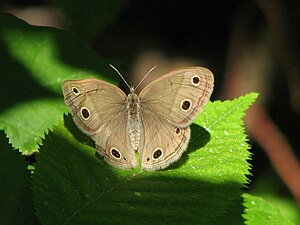Megisto cymela
| Megisto cymela | ||||||||||||
|---|---|---|---|---|---|---|---|---|---|---|---|---|

Megisto cymela |
||||||||||||
| Systematics | ||||||||||||
|
||||||||||||
| Scientific name | ||||||||||||
| Megisto cymela | ||||||||||||
| ( Cramer , 1777) |
Megisto cymela is a butterfly ( butterfly ) fromthe noble butterfly family (Nymphalidae).
features
butterfly
The wingspan of the moth is 38 to 48 millimeters. Fore and hind wings are brown in color on top. In the submarginal region there are two large, black eye spots with a faint yellowish border. The undersides of the wings are colored lighter brown. The top eye spots show through. They are outlined in bright yellow. On the underside of the hind wing there are mostly other, smaller ones in addition to the large eye-spots. Two thin, straight, dark brown to reddish brown colored transverse lines run on all undersides of the wings.
egg
The eggs are pale yellow-green and are laid individually on blades of grass, at the foot of tree trunks or on the ground.
Caterpillar
Adult caterpillars are pale brown or yellow-brown in color, have a dark topline, and wavy brownish side stripes and slashes. The body ends in two reddish tips. Two horns are only indicated very briefly on the yellow-brown head.
Doll
The doll has a pale yellow-brown basic color and is provided with many brown spots, dots and stripes. There are two flat combs on the back.
Subspecies
In addition to the nominate form Megisto cymela cymela , another subspecies is distinguished:
- Megisto cymela viola (Maynard, 1891)
Distribution and occurrence
The range of the species stretches from the south of the central and eastern Canadian provinces and further south through the central and the entire east of the USA to Texas and Florida . Megisto cymela prefers to colonize shady, wooded landscapes.
Way of life
The moths fly in one generation from March to July, depending on the region. They can sometimes still be found along the Gulf Coast at the end of September. These animals are likely to belong to a second generation. They rarely visit flowers to take in nectar. However, they occasionally suckle on injured trees or ingest honeydew droppings from aphids . Various grasses are named as food plants for the caterpillars, for example common ball grass ( Dactylis glomerata ) and Eremochloa ophiuroides . The caterpillar overwinters in the fourth instar.
supporting documents
Individual evidence
- ^ Butterflies and Moths of North America http://www.butterfliesandmoths.org/species/Megisto-cymela
- ↑ a b c d James A. Scott (1986). The Butterflies of North America: A Natural History and Field Guide. Stanford, California: Stanford University Press. ISBN 0-8047-2013-4 , p. 237
- ↑ Distribution and subspecies http://www.nic.funet.fi/pub/sci/bio/life/insecta/lepidoptera/ditrysia/papilionoidea/nymphalidae/satyrinae/megisto/index.html#cymela
literature
- James A. Scott (1986). The Butterflies of North America: A Natural History and Field Guide. Stanford, California: Stanford University Press. ISBN 0-8047-2013-4 , p. 237
Web links
- eol.org - Encyclopedia of Life
